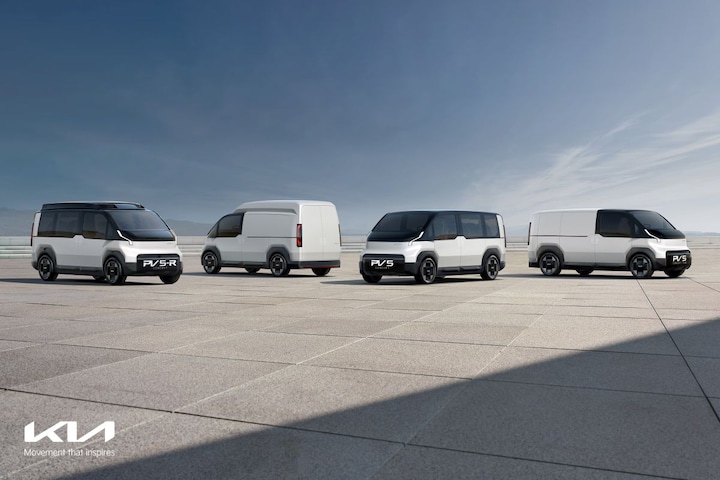Multi-purpose smart EVs


Kia has been making great strides in electric cars in recent years and it certainly doesn’t look like it is slowing down. In fact, it is expanding its EV activities and is launching a brand new modular platform that will be used by all kinds of electric models.
Like sister brand Hyundai, Kia has been talking about the arrival of so-called Purpose Built Vehicles (PBVs) for years. After all, under that somewhat elusive term – isn’t every vehicle built for a purpose? – the Koreans offer vehicles that ‘meet specific needs’. It is therefore less about electric passenger cars and more about EVs that the brand can use as a ‘mobility solution’. Think of electric commercial vehicles, passenger vans, compact shared cars and everything in between. Just under two years ago, Kia showed the first example of such a PBV in the form of Niro Plus, developed for the Korean taxi market, but in a few years the starting signal for Kia’s PBV offensive will sound a lot louder. This is when the first smart EVs on a completely new modular platform will come onto the market.
During the Consumer Electronics Show (CES) in Las Vegas, Kia is pulling the curtains on five fully electric, practical newcomers with which the brand makes clear what exactly it is going to do with its PBVs. Kia has developed a brand new modular platform to house its PBVs. More about that later. First the new EVs themselves. We start with the Kia Concept PV5. The brand has shown three variants and the PV5 is also Kia’s first PBV of the new family to come onto the market. First of all: the PBVs are intended for both companies and private individuals.
Kia PV5
The Kia PV5 is planned for 2025 and will be available in different variants, exactly as you often see with existing commercial vehicles. Kia is already mentioning the arrival of ‘Basic, Van and Chassis Cab variants’ and is also talking about the arrival of a ‘robot taxi’, an autonomously driving variant with multiple seats. It is currently called PV5-R and is being developed in collaboration with Motional – a partnership between Hyundai Motor Group and Aptiv.

Different variants of the Kia PV5.
Kia PV7
In what Kia refers to as the second phase of its PBV offensive, the brand is launching the PV7. This seems to be a larger and therefore more spacious alternative to the PV5. Assume that the PV7 will also be launched in several guises. The larger size of the PV7 also means larger battery packs and therefore a greater driving range, although we do not yet have technical data for any model that provides insight into this.
Kia PV1
The Kia PV1 will be – as its name suggests – the smallest PBV that Kia has in stock for the time being. The Kia PV1, like the PV7, is part of the second and therefore later phase of the PBV cycle. According to the Koreans, the Kia PV1 is “[…] optimized for agile logistics transport over short distances, using new drive modules to minimize the turning circle, even in small spaces.” Don’t be surprised if the PV1 eventually becomes not only a variant intended for logistics transport, but also a version intended for passenger transport is coming. We are still somewhat in the dark about the ‘new drive modules’.

The Kia PV1 (left) is the smallest of the bunch.
Modular
The platform of the PV models is modular and that goes beyond just the technology housed in it. For example, Kia speaks of rail systems in the roof, on the floor and on the sides of the cars, elements that allow the interiors to be cleverly divided with special cupboards, seats and frames. A major advantage of the PBV models is that once built they can serve multiple purposes. For example, the part behind the cabin can be placed in a different structure, according to Kia using a ‘hybrid electromagnetic and mechanical coupling’. For example, a PBV used as a taxi can serve as a delivery vehicle at night.

Kia foresees a huge role for smart computer systems.
Software
Kia’s Purpose Built Vehicles go hand in hand with what the brand calls a software-to-everything strategy (SDx). Digital ones and zeros will therefore play a major role. For example, the cars – including the PV5 – must be able to exchange data with each other, which, according to Kia, is ideal for a “software-driven fleet where, for example, route or delivery information can be optimally generated.” In what Kia calls the third phase of its PBV adventure, the brand is going one step further. Please note, it will become woollier.
According to Kia, in that third phase the PBVs ‘evolve’ into ‘highly customizable mobility solutions that are fully integrated with future mobility ecosystems. We quote Kia: “In this phase, PBVs evolve into live platforms that bring any idea to reality and connected, self-driving vehicles become part of smart city operating systems. With the emergence of a hyper-connected world where people, PBVs and social infrastructure are seamlessly connected, Kia can open the door to completely new lifestyles and business forms. The advanced PBV ecosystem will be based on Hyundai Motor Group’s future technologies in autonomous driving, advanced air mobility, robotics and the energy grid.” Correct.
In its home country of Korea, Kia is setting up a factory in Autoland Hwaseong that focuses entirely on the production of PBV models. The production facility will be operational by mid-2025. Ultimately, 150,000 PBVs should leave the factory gates every year.
– Thanks for information from Autoweek.nl












